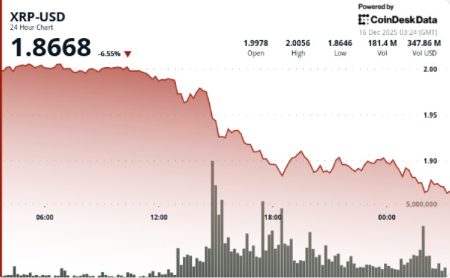Bitcoin’s October Slump Challenges ‘Uptober’ Tradition as Crypto Market Struggles to Recover
Crypto Market Faces Bearish October Despite Historical Trends
Bitcoin and the broader cryptocurrency market are experiencing an uncharacteristic slump during what has traditionally been a bullish month, leaving investors questioning whether the famed “Uptober” phenomenon has been canceled before it truly began. Contrary to historical patterns that have seen Bitcoin achieve an average gain of nearly 20% during October, the flagship cryptocurrency is currently down 4% this month, with most altcoins performing even worse.
October has historically been a strong month for cryptocurrency markets, with data from CoinGlass revealing a mean return of 19.84% for Bitcoin during this period over previous years. However, current market conditions paint a starkly different picture. While Bitcoin struggles with a 4% decline, Ethereum has fallen by 5%, and other major altcoins like Solana are experiencing double-digit percentage drops according to CoinGecko data. This negative performance comes as a disappointment to investors who typically anticipate October as a month of significant gains in the crypto sector.
The month began with promising momentum as buying pressure pushed Bitcoin from $115,000 to a new all-time high of $126,200 during the first week. This initial surge created optimism among traders and investors who believed the traditional “Uptober” rally was underway. However, macroeconomic pressures and intensifying U.S.-China trade tensions triggered a brutal market selloff on October 10th, creating a significant drawdown from which the crypto market has yet to fully recover. While traditional equity markets have managed to rebound from this same period of volatility—with the S&P 500 now trading near record highs—cryptocurrency markets continue to lag behind, suggesting deeper structural challenges.
Market Experts Confirm Correction Period for Cryptocurrencies
“It looks like it for the moment,” stated Julio Moreno, head of research at crypto on-chain data analytics platform CryptoQuant, when asked if “Uptober” has been canceled this year. Moreno’s assessment paints a sobering picture of current market conditions: “Basically, every on-chain metric indicates we remain in a correction period, and price action doesn’t look constructive.” This technical analysis suggests that despite multiple attempts to sustain momentum, the market is struggling to establish a clear bullish trajectory.
The current price action underscores this bearish sentiment. Bitcoin currently trades nearly 12% below its October 10th peak of $122,500 and is hovering just barely above its 200-day simple moving average—a technical indicator widely used to determine an asset’s long-term market trend. This precarious position has led to significant market uncertainty, with multiple failed attempts to push beyond the $113,000 resistance level this week. Tuesday’s trading session exemplified this volatility when Bitcoin surged nearly 5% in less than two hours during early New York trading, only to see those gains completely erased over the subsequent eight hours, with prices settling around $108,400.
“The sharp intraday swings we’re seeing across Bitcoin, Ethereum, and major altcoins reflect a cautious market sentiment,” explained Wenny Cai, Co-Founder and COO at crypto derivatives platform SynFutures. Cai described the current market dynamic as caught between institutional adoption optimism and pessimism driven by tightening global liquidity conditions. Given the historic liquidation cascade earlier this month, Cai characterized the current market behavior as “unsurprising,” noting that investors need time to reposition after such significant market dislocations.
Macroeconomic Factors and Future Outlook Remain Concerning
Both industry experts Moreno and Cai share a pessimistic outlook for cryptocurrency markets in the near term, despite some potentially positive macroeconomic developments. Even with the Federal Reserve’s decision to end quantitative tightening and market expectations for another quarter-point interest rate cut, the market sentiment remains subdued. This suggests that broader economic concerns are outweighing traditionally positive catalysts for cryptocurrency markets.
The most significant risks for cryptocurrencies continue to be macroeconomic uncertainty and the potential spillover effects from escalating U.S.-China trade tensions. These geopolitical and economic factors create headwinds that may continue to suppress crypto market performance regardless of sector-specific developments. Cai warned that if prices were to decline further, it could expose fundamental weaknesses in cryptocurrency exchange liquidity and place additional pressure on Bitcoin miners, potentially creating a negative feedback loop in market performance.
The correction period appears to be more prolonged than many market participants initially anticipated. “It takes time to reposition again,” Moreno noted, suggesting that investors may still be recovering from the psychological and financial impact of the October 10th market crash. This extended recovery period indicates that market sentiment remains fragile, with traders reluctant to take significant positions without clearer directional signals.
The current market conditions represent a deviation from the traditional “Uptober” pattern that cryptocurrency investors have come to expect. While historical seasonal trends have often proven reliable in cryptocurrency markets, this year’s performance serves as a reminder that external factors can override established patterns. As Cai succinctly concluded, “Until those factors stabilize, volatility is likely to remain the defining feature of this market,” suggesting that investors should prepare for continued uncertainty rather than anticipating an immediate return to the bullish October trend of previous years.
Market Volatility Reflects Broader Economic Tensions
The cryptocurrency market’s current struggles cannot be viewed in isolation from the broader economic landscape. The interplay between digital assets and traditional financial markets has grown increasingly complex as institutional adoption has increased. While cryptocurrencies were once considered potential “safe havens” during periods of economic uncertainty, the current market behavior suggests they remain vulnerable to many of the same forces affecting traditional asset classes.
The sharp price swings witnessed in recent trading sessions indicate a market struggling to find equilibrium amid conflicting signals. On one hand, the institutional infrastructure supporting cryptocurrencies continues to strengthen, with major financial institutions offering expanded crypto services and products. On the other hand, tightening global liquidity conditions and geopolitical tensions create significant headwinds that suppress risk appetite across all asset classes, including cryptocurrencies.
This tension between long-term adoption trends and short-term market pressures creates the volatile price action currently characterizing Bitcoin and major altcoins. The failed rally attempts followed by swift selloffs demonstrate that while buying interest exists at certain price levels, overall conviction remains weak. Until a clearer macroeconomic picture emerges or a significant catalyst materializes, this pattern of volatility without sustained directional movement may continue to define cryptocurrency markets through the remainder of what was supposed to be “Uptober.”
Implications for Cryptocurrency Investors and the Broader Market
For cryptocurrency investors, the current market environment presents both challenges and potential opportunities. The deviation from historical seasonal patterns serves as a reminder of the importance of fundamental and technical analysis over reliance on calendar-based trading strategies. While “Uptober” has been a reliable phenomenon in previous years, 2023 demonstrates that external factors can significantly alter expected market behavior.
The continued underperformance relative to traditional equity markets also raises questions about Bitcoin’s evolving role in investment portfolios. As the S&P 500 trades near record highs while Bitcoin remains well below its recent peak, investors may reassess assumptions about cryptocurrency’s diversification benefits and correlation patterns with other asset classes. This divergence could influence institutional allocation strategies and retail investor sentiment in the coming months.
Looking ahead, market participants will be closely monitoring several key factors that could influence cryptocurrency performance through the remainder of October and into the final months of the year. These include developments in U.S. monetary policy, shifts in the U.S.-China trade relationship, overall market liquidity conditions, and on-chain metrics that might signal changing investor behavior. Additionally, sector-specific factors such as mining profitability following Bitcoin’s halving earlier this year and regulatory developments will play important roles in determining market direction.
As the cryptocurrency market continues to mature and integrate with the broader financial system, investors may need to adjust their expectations regarding seasonal patterns and historical correlations. The cancellation—or at least postponement—of “Uptober” this year serves as a reminder that cryptocurrency markets, despite their unique characteristics, remain influenced by the same fundamental economic forces that drive all financial markets. Until those underlying conditions stabilize, the traditional October rally may remain elusive, leaving investors to navigate a more complex and challenging landscape than in previous years.















